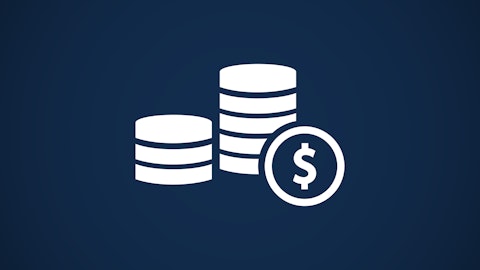Intel’s Key Risks
The world has changed a lot since Intel incorporated nearly 50 years ago.
For one thing, computers were extremely rare and largely unavailable to the public. The first microprocessor didn’t even exist until 1971.
Today, computers are everywhere, and relatively new devices such as tablets and smartphones are beginning to erode total demand for Intel’s legacy cash cow – PCs (close to 50% of operating profits). If demand falls faster than expected, Intel’s profits could struggle to grow.
Recent data from Gartner showed that global PC shipments fell by nearly 10% in the first quarter of 2016, suggesting that PC headwinds aren’t abating any time soon.
Intel benefited for many years from the rapid ascent of computers, which drove strong demand for its microprocessors.
However, the company must now rely on other growth drivers to remain competitive, especially if the market for PCs contracts faster than expected (we don’t think it will, but you never know).
As we noted earlier, Intel is already dominate in data center processors, but the company is working to capture a meaningful market share in mobile devices and a broad array of “Internet of Things” devices.
The company is leveraging the scale and intellectual property from its legacy PC business, but that certainly doesn’t guarantee its success in gaining a strong and profitable market share in these emerging growth industries.
Intel’s push in these industries is also pitting it against competitors and threats it didn’t previously face in the PC market.
Perhaps most notably, cutting-edge tech giants such as Facebook Inc (NASDAQ:FB), Apple Inc. (NASDAQ:AAPL), and Alphabet Inc (NASDAQ:GOOGL) have increasingly expressed a desire to make their own chip designs and leverage other suppliers to push back on Intel’s pricing.
They are well aware of the monopoly profits enjoyed by Intel and increasingly view hardware as a performance differentiator, increasing the incentive to develop their own intellectual property and processes. Intel already has a large custom chip business, but it’s worth remembering this risk factor.
The biggest competitive threat to Intel’s data center processor business, which is responsible for driving the far majority of the company’s profit growth, is ARM Holdings plc (ADR) (NASDAQ:ARMH).
ARM uses a different architecture than Intel and currently dominates the smartphone market, which relies on smaller chips. Unlike Intel, ARM Holdings plc (ADR) (NASDAQ:ARMH) is a chip designer that makes money from licensing and doesn’t do any manufacturing.
ARM’s first chips for data center servers are expected to ramp up this year. It’s hard to imagine that these chips will be able to match Intel’s high level of performance, but it’s worth monitoring ARM Holdings plc (ADR) (NASDAQ:ARMH)’s progress trying to challenge Intel’s major profit driver. For now, we believe Intel’s incumbency and performance advantages in data center processors will be hard to uproot.
A final risk factor to note is that semiconductor technology is constantly evolving. Microprocessors become faster and more powerful each year while also shrinking in size and cost.
While Intel is one of the only companies with the financial strength and reputation to invest in the best manufacturing processes and R&D, the pace of chip improvements has begun to slow in recent years as the physics of chips has become extraordinary complex.
If innovating in performance and power becomes increasingly difficult, the competitive gap between Intel and its competitors could begin to narrow. Intel could also begin to realize a lower return from its multi-billion dollar investments.
Dividend Analysis: Intel
We analyze 25+ years of dividend data and 10+ years of fundamental data to understand the safety and growth prospects of a dividend. Intel’s long-term dividend and fundamental data charts can all be seen by clicking here.
Dividend Safety Score
Our Safety Score answers the question, “Is the current dividend payment safe?” We look at factors such as current and historical EPS and FCF payout ratios, debt levels, free cash flow generation, industry cyclicality, ROIC trends, and more. Scores of 50 are average, 75 or higher is very good, and 25 or lower is considered weak.
Intel has one of the best Dividend Safety Scores in our database, which suggests that its dividend payment is extremely safe.
The company’s strong dividend safety rating begins with Intel’s healthy payout ratios. As seen below, Intel’s earnings and free cash flow payout ratios were both about 40% in 2015, which provides the company with plenty of flexibility to continue paying and growing the dividend.
Even if cash flow was unexpectedly cut in half, Intel would have the financial strength to continue paying its dividend (its dividend payout ratio would double to 80%).

Source: Simply Safe Dividends

Source: Simply Safe Dividends
Another factor we analyze to gauge the safety of a dividend payment is how a company performed during the last recession. Intel’s sales fell by 2% and 7% in fiscal years 2008 and 2009, respectively. The company’s earnings also dropped by 22% and 16% in 2008 and 2009, respectively. Earnings fell more than sales because Intel has a high amount of fixed costs – the company’s multi-billion dollar manufacturing plants had less volume to spread their costs over.
Not surprisingly, businesses and consumers alike cut back on discretionary spending when times get tough, and fewer electronics such as computers are purchased. Intel’s stock was also hit fairly hard during the recession, falling by 43% in 2008 to trail the S&P 500 by about 6%.

Source: Simply Safe Dividends





